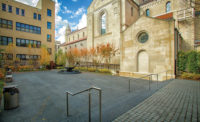According to Marbrasa, the San Gabriel Black site is the largest black granite quarry in the world. There is a total of 160 workers responsible for extracting blocks and processing them into raw slabs, along with an additional support team of 20 people to provide transportation, meals and administration.
In addition to the U.S., leading consumers of San Gabriel Black granite are within South America, including the domestic market as well as nations such as Chile, Argentina and Colombia.
Operations
Multiple areas of the massive San Gabriel Black quarry are being worked simultaneously, and diamond wire saws are a key component of the extraction process. During Stone World’s visit to the site, a total of six different levels of the quarry were being extracted, and a seventh level is expected to be opened within the next two years.
The quarry has been in operation for 40 years, and it has reserves that will allow it to continue yielding stone for many years into the future.
Adding to the efficiency of the San Gabriel Black quarry, blocks are processed into slabs directly at the site. Multiwire saws from Wires Engineering are used to cut quickly blocks into raw slabs — far surpassing the speed and precision of gangsaw cutting — and they operate with diamond wire from Co.fi.plast.
Each block and slab is color coded using a sophisticated system that identifies the location of the quarry where the blocks was quarried, along with the date that it was cut and processed. Marbrasa keeps a detailed inventory of its materials at all stages, from the time it was produced to when it was warehoused to after it was sold.
An advanced water treatment system is in place at the San Gabriel Black site, and a total of 70% of water is recycled back into the process.
A “green” culture
Following a pattern that can be found throughout Marbrasa’s operations, the San Gabriel Black quarry follows strict environmental standards. With a corporate theme of “Naturais Marbrasa,” the company strives to “believe in the value of life above all else and preserve the surrounding environment in which it operates.”
With this noble mission in mind, the company redevelops exhausted areas of the quarry site by planting three to four times as many trees as required by national law. It has an extensive nursery for dozens of species, including Ipé, Sapucaia, Jatobá and Pau-Brasil — the tree that gave its name to the country 500 years ago. Well more than 100,000 trees have been planted by Marbrasa in its effort to reclaim the natural beauty of the land.
Growing seedlings are given special care until they are resistant enough to be transferred to their final planting location. Moreover, seeds, plants and seedlings are offered to employees and communities around the quarries.
In the near future, Marbrasa will continue its pattern of expansion, and it is already taking measures to ensure it continues its care for the environment. A new industrial plant will be built closer to the quarries, and this new facility is expected to produce twice the current capacity of the company. The land for the site has already been prepared, and in the middle of the space, a large wooded area is in place with dozens of tree species being grown. Already, Marbrasa’s workers have affectionately nicknamed the area “Central Park.”












